Top News
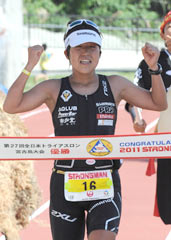
April 25, 2011 ,by Yuuna Fukuhara,staff writer of Ryukyu Shimpo
THE 27th ALL JAPAN TRIATHLON MIYAKOJIMA was held on Miyakojima Island on April 24 (co-hosted by Miyakojima City and Ryukyu Shimpo)
One thousand three hundred forty six competitors (1176 male and 170 female) took part in this very strenuous event, which consisted of a three-kilometer swim, a 155-kilometer bicycle ride followed by a 42.195-kilometer full marathon.
The lead in the men’s race changed from one moment to the next, with Hayato Kawahara, from Tokyo, eventually coming out on top with a time of 7 hours 46 minutes 5 seconds, winning the competition for the first time in three years. This is his second victory.
Kawahara, who was in 11th place after the bicycle ride, overtook 10 opponents in the full marathon.
Local Okinawan resident Kanji Kuwabara came second, followed by Masayuki Matsumaru of Ibaraki Prefecture.
In the women’s race, Emi Shioya of Tokyo was victorious with a time of 8 hours 39 minutes 19 seconds, winning the competition for the first time in five years – her second victory.
Dominant in the full marathon, Shioya ran unchallenged in the final phase of the race.
Hiromi Matsumaru of Ibaraki came second, followed by Mai Taketomo of Fukuoka.
This is the third time in three years that Japanese have won both the men’s and women’s competitions.
Shioya, who broke the finishing tape at THE 27th ALL JAPAN TRIATHLON MIYAKOJIMA for the first time in five years, could not hold back tears of joy after winning the competition.
In the course of her training in New Zealand in January, Shioya collided with a boat when practicing swimming and injured herself. She looked back on her loss of form, saying, “I slipped off track.”
Discouraged and having lost her enthusiasm, Shioya said, “I totally lost my drive to perform in triathlons.” Unsure as to whether she was up to it even after she arrived at Miyakojima, Shioya said, “I was still uncertain if I could manage it.”
However, Shioya was saved by the words from the coach who had instructed her in New Zealand. “You have put in enough practice, so you will be all right.” These words gave her the lift she needed to change gear emotionally.
Although Shioya was six minutes behind the leader in the swim, she moved to the front with Hiromi Matsumaru in the bicycle ride, the part in which Shioya was confident of her ability. In the second half of that portion of the competition, Shioya boldly challenged Matsumaru and wore down her opponent. “I felt things going my way, so I tried to put pressure on her,” she said.With enough reserves of energy left, Shioya then took on the full marathon, in which she left the rest of the field in her wake after the first four kilometers. When it was over, Shioya had won the competition, having successfully displayed the difference in the quality of her ability.
Having come second for four consecutive years until this event, she looked relieved, saying, “I finally broke the jinx.”
Asked about the next competition, she declared in a tone befitting her status, “I look forward to defending my position as All Japan Champion.”
(English Translation by T&CT, Mark Ealey)
Go To Video
Go To Japanese
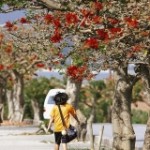
April 17, 2011. by Masatoshi Inafuku, staff writer of Ryukyu Shimpo.
Taketomi Island – deigo tree flower viewing is at its best from early April on Taketomi, one of the Yaeyama Islands south-west of Okinawa. Deigo trees damaged by insects called Deigo-himekobachi, have been the cause of concern on the island since 2005. Residents responded by setting up an executive committee to ‘Save the Taketomi Deigo!’ (Yoshinori Uesedo, chairman of the Taketomi Community Center), carrying out a campaign to inject a special insecticide into the trees to eradicate the pests. The islanders worked hard for about six years to collect money and to treat the trees, most of which were saved and went on to bloom successfully. The locals are now thrilled to see the result of their labor – deigo flowers in full bloom.
On April 9, a beautifully fine day, many visitors and residents took photographs beside the deigo trees lining the road leading down from the village toward the harbor. It was a truly beautiful scene with the bright red blooms of the flowers on the trees contrasting with the blue sky and view of Ishigaki Island off in the distance. Many of the deigo trees still having buds yet to open is likely that people will be able to enjoy the flowers in full bloom for the rest of this month.
It cost two million yen to purchase the insecticide used to eradicate the deigo-himekobachi. The Prefectural Forest Resources Research Institute advised that the treatment was needed urgently so the Taketomi Community Center covered the initial outlay to purchase the drug and the Committee paid it back later with the proceeds from running fund-raising activities, including music festivals in conjunction with the local Taketomi residents’ organization.
The islanders also volunteered their time to carry out the task of injecting the trees. “In the language of flowers, deigo represents a ‘dream.’ We realized our dream through Taketomi’s ‘Utsugumi’ (spirit of mutual support). We hope that we can help spread this spirit across the nation,” Uesedo said.
(English Translation by T&CT, Mark Ealey)
Go TO Japanese
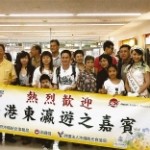
April 17, 2011 Ryukyu Shimpo
On April 16, Hong Kong companies resumed tours to Japan after halting them after the Great East Japan Earthquake.
Hong Kong tour company EGL Tours brought 63 tourists, including media people, to Okinawa from Hong Kong. All such companies in Hong Kong suspended tours to Japan soon after the March 11 earthquake. Okinawa is the first Japanese prefecture to welcome in tourists from that region of China since then.
Taking this opportunity to promote Okinawa to Hong Kong, the prefecture invited the group of tourists to watch the Ryukyu Kaiennsai (Okinawa Seaside Fireworks Festival) held in Ginowan City, on a cruise ship.
In the welcome ceremony held on the ship, Governor of Okinawa Hirokazu Nakaima said, “We are grateful to the people of Hong Kong for choosing Okinawa as the first place in Japan to resume tours to. We will do our best to ensure that tourists can enjoy themselves in the lead-up to summer.”
A female member of the tour group, the first person to book a place on the tour said, “I came on this tour to support Japan. I heard that Okinawa is a particularly safe place among the prefectures of Japan. I really want to enjoy my time here.”
This group of tourists is scheduled to stay four days, visiting such sightseeing spots as the Okinawa Churaumi Aquarium.
(English Translation by T&CT, Mark Ealey)
Go To Japanese
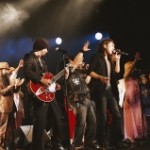
April 16, 2011 Ryukyu Shimpo
The “A-Sign Story,” about the evolution of Okinawan rock music, was performed at Music Town Oto Ichiba in Okinawa City on the night of April 8.
The performance was delivered as an Ongakugeki, an alternative form of musical in which the singing and dancing is separated from the acting. The show covers the unique background of Okinawan rock music, which developed out of what were referred to “A-Sign bars” – U.S. military government approved bars and restaurants that flourished through catering for U.S. military personnel during the Vietnam War.
The story not only covers the history of Okinawan rock, but also such issues as U.S. military bases, the local backlash against U.S. military personnel, and discrimination against the half Japanese and half American children, and thereby reflects the thinking and events surrounding the “city of military bases.”
Major players of Okinawan rock such as Kachan, Shinki and Samee, and Eiichi Miyanaga appeared among the band performances and the range of colorful dances.
While the fortunes of A-Sign bars were on the decline in the early 1970s due to the combined impact of the Nixon Shock in 1971 and the reversion of Okinawa to Japanese administration in 1972, there was no doubting the fact that more Japanese had started to go to clubs with live music. During the transition period of Okinawan rock, young artists such as Porkees and Hideyuki Maeda appeared, giving hope for the renaissance of Koza as a “music town.”
“A-Sign Story” was originally scheduled to be performed in March as part of the Okinawa International Asia Music Festival but was cancelled due to the Great East Japan Earthquake, before eventually being held to raise funds for earthquake relief. Yukio Kyan, who wrote and performed in “A-Sign Story” said, “We would like to appeal for world peace from the city of military bases, the birthplace of Okinawan rock, and to use music to support people in disaster-stricken areas.”
(English Translation by T&CT, Mark Ealey)
Go To Japanese
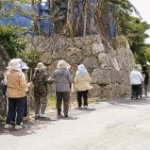
April 15, 2011 Ryukyu Shimpo
“Nerpai,” a traditional Ryukyuan ritual in which people pray for a good harvest and set up charms against tsunami, was carried out in Miyakojima City on April 12.
The citizens of two villages, Sunagawa and Tomori, took part in the ritual. Local women prayed for calm in society and set up bamboo sticks known as “datifu” or “danchiku” at designated spots as charms to keep tsunami away.
In the morning, the local people gathered at Wipyayama, where women sang a Ryukyuan divine song called “Niri” and prayed in the sacred room at Mywipya in Sunagawa. The women then walked in a line and set up “datifu” sticks at designated spots, praying that their homes will be safe from tsunami. After the women left, the men remained at Wipyayama to conduct the ritual in which they sang a sacred song and performed the motions of rowing a boat.
People carry out the “Nerpai” ritual every year on the first day of the Rooster in the third month of the old lunar calendar. In recent times, most of the participants are residents of the two villages of Sunagawa and Tomori, but in the past people from other villages such as Gusukubebora, Uenoarazato and Miyaguni were also involved.
Although the origin of the “Nerpai” ritual is unclear, it is said that an old document dating back to 1748 includes a description of a ritual very similar to it.
A participant in the ritual, Akemichi Uezato, said, “Fewer and fewer people are taking part and not that many even know of its existence. While it may seem that we are only making a wish to a god, I do think that it is important for us to remind ourselves of disaster prevention once a year.”
(English Translation by T&CT, Mark Ealey)
Go To Japanese
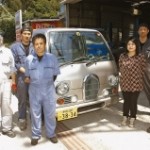
April 13, 2011 Ryukyu Shimpo
Nagamine Automobile Maintenance Factory, headed by Akira Nagamine, succeeded in converting a gasoline-driven vehicle to one powered by electricity, which was then registered and given a number plate.
This is the first time in Okinawa that an automobile maintenance factory has registered an electric-powered vehicle that has been converted from a gasoline-driven car. They removed the engine and fuel tank from a lightweight truck and replaced these with a lead battery and a motor. The cost of the conversion was about one million yen.
Boasting a maximum speed of 80 kilometers per hour, the vehicle can cover about 40 kilometers on a single charge. The running cost is about one to two yen per kilometer, which is about one-tenth the cost of running a gasoline-driven vehicle. The feel of the ride is similar to that of a golf cart.
Nagamine Automobile Maintenance Factory launched the electric vehicle conversion service as a new business venture in the context of the automobile industry tightening as sales slow down due to the reduction of the number of items required in a vehicle safety inspection.
Nagamine Factory staff succeeded with the electric vehicle conversion in January after undergoing training with companies in other prefectures. The vehicle received its number plate on March 28.
The Nagamine Automobile Maintenance Factory intends to carry out further research to enable them to run the conversion service as a viable business. Nagamine said, “Electric vehicles will become widely used in Okinawa because we have the advantage of being an isolated island with relatively short distances to travel. … If the cost of lithium-ion batteries decreases, we will be able to develop this business plan further.”
Photo: Akira Nagamine (on the right), head of Nagamine Automobile Maintenance Factory, and his staff, stand beside the vehicle converted from gasoline to electric power at their factory in Onna-son, Okinawa
(English Translation by T&CT, Mark Ealey)
Go To Japanese

April 12, 2011. Ryukyu Shimpo.
Taketomi on Iriomote Island: “Yon,” a male Iriomote wildcat raised for about 14 years and eight months in the Iriomote Wildlife Conservation Center run by the Ministry of the Environment, died at 1:59pm on April 9. His estimated age of 15 years and one month is the longest confirmed age for his species. He led a full life, the equivalent of over 100 years of age for a human.
Yon was found after being hit by a car on the prefectural road in the Island. To heighten public awareness and for research purposes, he was then looked after in the Iriomote Center, because of the difficulty involved in reintroducing him to the wild. The only wildcat known to have survived such an accident, he then came close to death through illness in December 2010 but gradually recovered, before his condition deteriorated once again on April 5. His body was taken to the Agricultural Department of the Kagoshima University where an autopsy will be performed to determine the cause of death.
(English Translation by T&CT, Mark Ealey)
Go To Japanese
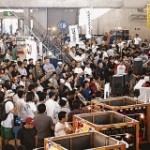
April 12, 2011. Ryukyu Shimpo
The 2011 Fishing Trade Show was held at the Okinawa Convention Center in Ginowan City in Okinawa on April 9 and 10, with 72 companies related to fishing and boat manufacturing participating from Okinawa and further afield. Many fishing fans came to get a chance to handle the latest fishing gear.
At a talk show run as part of the event, well-known fishing instructors Minoru Matsuda, Masanori Uzawa, Akira Ohchi, Takuya Hirawa and Reiko Kodama spoke enthusiastically about the thrill of fishing.
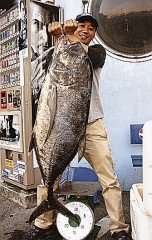
Taku Oda shows his Ronin-aji (123cm long and weighing 20.5kg) at Zamami Island on April 2, 2011. He used Okinawan octopus for bait.
We all know that staying safe at all times and keeping to the established rules and protocols of fishing is just as important as ever.
(Reported by Osamu Nakaema, Okinawa Fishing Kingdom Company.)
(English Translation by T&CT, Mark Ealey)
Go To Japanese
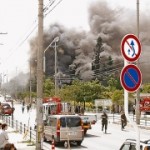
Fifteen years on since the Futenma agreement between US and Japan – “Level of risk to residents unchanged.”
April 12, 2011 by Teppei Ikeda, Ryukyu Shimpo.
Ginowan City – 15 years have passed since Japan and the United States agreed that the Marine Corps Air Station Futenma would be returned to Okinawa in 2006. During that period, on August 13, 2004, a U.S. military helicopter crashed into a building at Okinawa International University.
The Ginowan Municipal Office has published a brochure illustrating the dangers posed by the Futenma Air Station to local residents. The cover of the brochure features a photograph taken shortly after the helicopter crash by 47 year-old Hideo Miyazato, who is quoted as saying, “The dangerous situation that we face has not changed at all in the last fifteen years. The voice of citizens calling for the elimination of the risk of accidents does not seem to have got through to the Government.” He is dismayed at the situation and demands the closure of the Futenma Base and the return of the land to its owners as soon as possible.
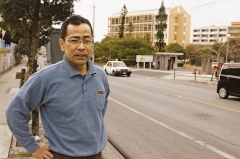
Hideo Miyazato looking back on the scene of the helicopter crash from near the spot where he took a photograph, March 11, 2011. Ginowan City.
Moments after the accident occurred, local residents stood stunned in front of the burning helicopter as emergency warning sirens sounded everywhere around them. U.S. soldiers rushed into the University campus, evicting students and administrative staff, and even refusing to give access to local Japanese police. He struggled to comprehend the scenes that he had captured on his camera, saying, “I thought, ‘Surely this can’t be for real.’” Miyazato ran a key shop near the campus, so for him helicopters flying overhead was an everyday occurrence.
“If that helicopter had crashed just a few minutes earlier…” said Miyazato in a voice tinged with horror as he recalled that he had passed by the scene of the accident just five minutes before the crash on his motorcycle taking his 11 year-old son Tatsuki to a nearby cram school. “That was the day that my family realized that we are in constant danger,” he added as he looked back at the scene of the accident. The buildings that were destroyed in the crash were rebuilt and seven years later Tatsuki, then an elementary school pupil, is now a university student. Miyazato said, “Our memories of that day have gradually faded, but we have no assurance that our family will not be caught up in such an accident. I shudder at the thought.”
Miyazato stated, “I think the fact that the Government is trying to move the facilities at Futenma to Henoko in the northern area of Okinawa against the will of the people will make it difficult to resolve the Futenma issue within the next 15 years.” He emphasized, “We are concerned about the safety of our families. The Government should try to scale down the size of the base without building a new facility and should eliminate the risk to local society as soon as possible.”
(English Translation by T&CT, Mark Ealey)
Go To Japanese
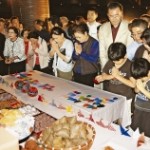
April 10, 2011 Ryukyu Shimpo
On April 9, during the Seimei Festival, in which Okinawan people hold a memorial service for their ancestors, the fourth Cornerstone of Peace Memorial Seimei Festival for the souls of war dead whose names are engraved on the marble tablets at Mabuni was held at Okinawa Peace Prayer and Memorial Hall in Mabuni, Itoman. Organized by the Okinawa Association, the Festival was attended by approximately 400 people who prayed for the repose of the souls of those killed in the Battle of Okinawa.
People made offerings of Seimei Festival food in front of the Peace Prayer Statue, as they paid tribute to the war dead and prayed for lasting peace.
Fumiko Ikari, an Okinawan dialect radio newscaster, read out the message: “The wish for the world of the benevolent bodhisattva,” in the Okinawan dialect. Sachiko Kina, the head of the Shinyoryu-Kaki Society, performed some dedication dances including the Ryukyuan classical dance “Nnimajin.” Those attending also gave offerings of Ryukyu thread balls and origami birds.
Namiyo Higa, who came from Naha to the Festival with her two children, said, “With the East Great Japan Earthquake having happened recently, we came to the Festival to try to convey the value of life to our children.”
(English Translation by T&CT, Mark Ealey)
Go To Japanese
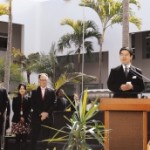
April 7, 2010 Ryukyu Shimpo
The Okinawa AMICUS International School (AMICUS) was opened in Enobi, Uruma-City, Okinawa on April 7.
AMICUS will accept children of researchers at the Okinawa Institute of Science and Technology (OIST), which is scheduled to open in the 2012 academic year. It is the first school in Japan to run two separate courses within the same system: the international course and the immersion course in which Japanese and non-Japanese children study together.
This academic year, 197 children will enroll in the AMICUS elementary and junior high school and kindergarten sections, which cater for first to fourth grade pupils.
At the opening ceremony, Akira Yamauchi, the principal of AMICUS, said, “The aim of our school is to encourage children to expand their knowledge, to learn how to think on their own, and to act by themselves. Our educational philosophy aims to create independent students.”
Yamauchi’s address was followed by the entrance ceremony, at which representatives of Okinawa Prefecture, Uruma City and Obunsha Publishing Co., Ltd. exchanged memorandums on the establishment of AMICUS in July 2008. The preparation for the opening of AMICUS was carried out by the Okinawa Kokusai Gakuen Establishment Preparatory Foundation.
(English Translation by T&CT, Mark Ealey)
Go To Japanese













 Webcam(Kokusai Street)
Webcam(Kokusai Street)


